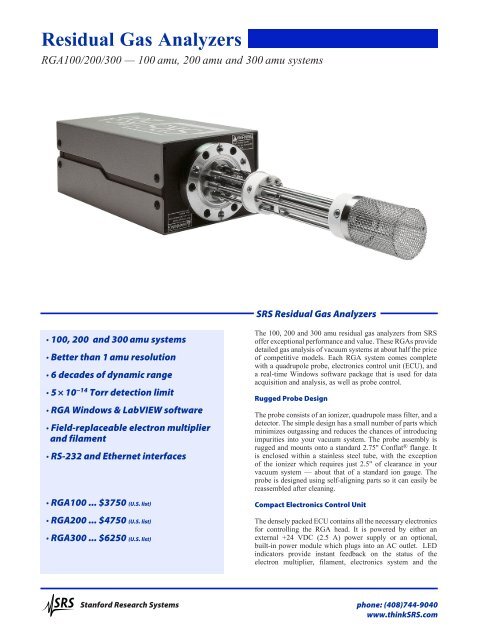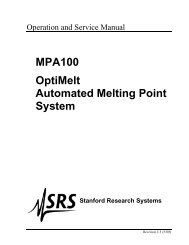Residual Gas Analyzers - Stanford Research Systems
Residual Gas Analyzers - Stanford Research Systems
Residual Gas Analyzers - Stanford Research Systems
- No tags were found...
Create successful ePaper yourself
Turn your PDF publications into a flip-book with our unique Google optimized e-Paper software.
RGA100/200/300 <strong>Residual</strong> <strong>Gas</strong> <strong>Analyzers</strong>The software also allows complete RGA head control witheasy mass scale tuning, sensitivity calibration, ionizer setup,and electron-multiplier gain adjustment. For further analysis,data files can be saved in ASCII format for easy transfer intospreadsheets. Graphic images can be saved as META filesor copied to the clipboard for importing directly into otherWindows programs. The software also provides passwordprotection for locking out head parameters so that casualusers can’t alter important settings. A LabVIEW driver is alsoavailable on the SRS website.An optional stand-alone monitor (PPM100) can be used tocontrol the RGA without a host computer.Multi-Head OperationThe software supports multiple head operation when morethan one RGA is needed. Up to eight ECUs can be monitoredfrom the software.Performance and ValueThe SRS family of RGAs is ideal for applications involving gasanalysis, leak detection, and vacuum processing. We offer 100,200 and 300 amu systems with supporting Windows software,and options that include an electron multiplier and a built-inpower module for AC line operation. The RGA Windowssoftware is available on the web at www.thinkSRS.com.RGA rear panel(without AC power module)RGA rear panel(with AC power module)RGA dimensional drawing (inches)<strong>Stanford</strong> <strong>Research</strong> <strong>Systems</strong> phone: (408)744-9040www.thinkSRS.com
RGA100/200/300 SoftwareAnalog mode provides a line graphrepresentation of the acquired massspectrum (partial pressure vs. massnumber). Span, resolution and noise floorcan each be set. Scans can be single-shot,timed or taken continuously.Pressure vs. time presents a strip chart ofpartial pressures for selected masses, andprovides a complete time history of yourdata. Complete scrolling and zoom controlis available even while data is beingacquired. This mode is most often used formonitoring process trends.Library mode contains a comprehensivelist of gases that can be used to compareagainst the current spectrum. A searchmode allows you to select up to 12 massesand identify and display (numerically andgraphically) the intensity of all gases thatcontain these masses.Histogram mode displays a bar graph ofpartial pressure vs. mass, allowing thespectrum to easily be interpreted. Thismode is often used for quick and easyvacuum analysis. The screen can be splitfor viewing two modes of operationsimultaneously.Leak detection mode monitors a particularmass number (not just helium) over time,and combines many features of the previousmodes. A vertical bar graph provides avisual reference for viewing changes inintensity from a distance. A programmableaudible tone, large numeric read-out, andvisual alarm are also provided.Analysis utility provides an approximationof the composition of gases beingmonitored by the RGA. Since more thanone gas can contribute to a particularamu’s partial pressure, the analysis mode isextremely useful in determining the makeupof complex gases. Up to 12 commongases can be selected for the analysis.Table mode provides a readout of mass,scaling factor, and true partial pressure.The display shows the peak heights andalarm status of up to 10 masses. Theelectron multiplier can be independentlyset on or off for each mass. This allowsthe user to view minor species even in thepresence of high total pressure.Annunciator mode is provided forconveniently monitoring up to 10 masses.If a particular mass has tripped its presetalarm, the large box will turn red indicatinga problem. An audible alarm will also bepresent until the mass falls back within itspreset limits. This mode is most often usedfor Go/No-Go testing.Multi-head operation is available whenmore than one RGA is needed for analysis.Up to eight heads can be monitoredsimultaneously from the software.<strong>Stanford</strong> <strong>Research</strong> <strong>Systems</strong>phone: (408)744-9040www.thinkSRS.com
RGA100/200/300 SpecificationsOperationalMass rangeRGA100 1 to 100 amuRGA200 1 to 200 amuRGA300 1 to 300 amuMass filter type QuadrupoleDetector type Faraday cup (FC), standardElectron multiplier (EM), optionalResolutionBetter than 0.5 amu @ 10 % peak(per AVS std. 2.3) height. Adjustable to constant peakwidth throughout the mass range.Sensitivity (A/Torr) 2 × 10 –4 (FC),
















